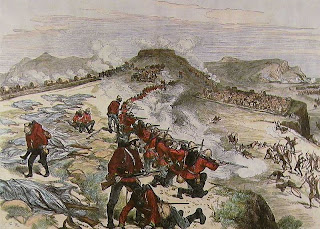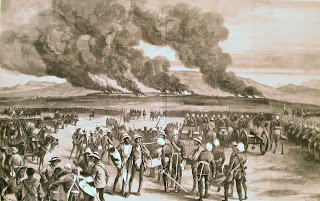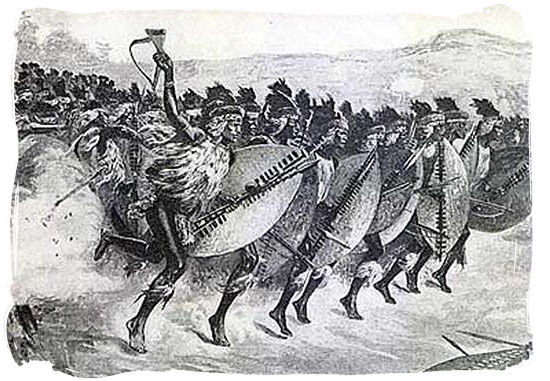Anglo-Zulu War
The Zulu People and Zululand
 |
| Zulu warrior |
The Zulu are the largest South African ethnic group, with an estimated 10–11 million people living mainly in the province of KwaZulu-Natal. Small numbers also live in Zimbabwe, Zambia, and Mozambique. Their language, Zulu, is a Bantu language; more specifically, part of the Nguni subgroup. The Zulu Kingdom played a major role in South African history during the 19th and 20th centuries. Under apartheid, Zulu people were classed as third-class citizens and suffered from state-sanctioned discrimination. They remain today the most numerous ethnic group in South Africa, and now have equal rights along with all other citizens.
The Zulu Kingdom, sometimes referred to as the Zulu Empire or, rather imprecisely, Zululand, was a monarchy in Southern Africa that extended along the coast of the Indian Ocean from the Tugela River in the south to Pongola River in the north.
The small kingdom grew to dominate much of Southern Africa, but when it came into conflict with the British Empire in the 1870s during the Anglo-Zulu War, it was defeated despite early Zulu victories in the war. The area was subsequently absorbed into the Colony of Natal and later became part of the Union of South Africa. (From Wikipedia)
Historical Background
 |
| Cetshwayo, the king of Zulu |
In 1862, Umtonga, a brother of Cetshwayo, son of Zulu king Mpande, fled to the Utrecht district, and Cetshwayo assembled an army on that frontier. According to evidence later brought forward by the Boers, Cetshwayo offered the farmers a strip of land along the border if they would surrender his brother. The Boers complied on the condition that Umtonga's life was spared, and in 1861 Mpande signed a deed transferring this land to the Boers. The south boundary of the land added to Utrecht ran from Rorke's Drift on the Buff to a point on the Pongola River.
The boundary was beaconed in 1864, but when in 1865 Umtonga fled from Zululand to Natal, Cetshwayo, seeing that he had lost his part of the bargain (for he feared that Umtonga might be used to supplant him, as Mpande had been used to supplant Dingane), caused the beacon to be removed, and also claimed the land ceded by the Swazis to Lydenburg. The Zulus asserted that the Swazis were their vassals and therefore had no right to part with this territory. During the year a Boer commando under Paul Kruger and an army under Cetshwayo were posted to defend the newly acquired Utrecht border. The Zulu forces took back their land north of the Pongola. Questions were also raised as to the validity of the documents signed by the Zulus concerning the Utrecht strip; in 1869 the services of the lieutenant-governor of Natal were accepted by both parties as arbitrator, but the attempt then made to settle disagreements proved unsuccessful.
Bartle Frere was relegated to a minor post in Cape Town.
A Resident was appointed to be the channel of communication between the chiefs and the British government. This arrangement led to much bloodshed and disturbance, and in 1882 the British government determined to restore Cetshwayo to power. In the meantime, however, blood feuds had been engendered between the chiefs Usibepu (Zibebu) and Hamu on the one side and the tribes who supported the ex-king and his family on the other. Cetshwayo's party (who now became known as the Usuthu) suffered severely at the hands of the two chiefs, who were aided by a band of white freebooters.
When Cetshwayo was restored Usibepu was left in possession of his territory, while Dunn's land and that of the Basuto chief (the country between the Tugela River and the Umhlatuzi, i.e. adjoining Natal) was constituted a reserve, in which locations were to be provided for Zulu unwilling to serve the restored king. This new arrangement proved as futile as had Wolseley's. Usibepu, having created a formidable force of well-armed and trained warriors, and being left in independence on the borders of Cetshwayo's territory, viewed with displeasure the re-installation of his former king, and Cetshwayo was desirous of humbling his relative. A collision very soon took place; Usibepu's forces were victorious, and on the 22 July 1883, led by a troop of mounted Boer mercenary troops, he made a sudden descent upon Cetshwayo's kraal at Ulundi, which he destroyed, massacring such of the inmates of both sexes as could not save themselves by flight. The king escaped, though wounded, into Nkandla forest. After appeals to Melmoth Osborn he moved to Eshowe, where he died soon after
(From Wikipedia)
Such was the political background when Cetshwayo became absolute ruler of the Zulus upon his father's death in 1873. As ruler, Cetshwayo set about reviving the military methods of his uncle Shaka as far as possible, and even succeeded in equipping his regiments with firearms. It is believed that he caused the Xhosa people in the Transkei to revolt, and he aided Sikukuni in his struggle with the Transvaal. The activities of the missionaries were unwelcome to Cetshwayo. Though he did not harm the missionaries themselves, several converts were killed. The missionaries, for their part, were a source of hostile reports. For example, Bishop Schreuder (of the Norwegian Missionary Society) described Cetshwayo as "an able man, but for cold, selfish pride, cruelty and untruthfulness, worse than any of his predecessors."
 |
| Battle of Rocke's Drift |
In 1874 Lord Carnarvon, who had successfully brought about federation in Canada, thought that a similar scheme might work in South Africa. Sir Bartle Frere was sent to South Africa as high commissioner to bring it about. One of the obstacles to such a scheme was the presence of the independent states of the South African Republic and the Kingdom of Zululand.
In September 1876 the massacre of a large number of girls (who had married men of their own age instead of men from an older regiment, as ordered by Cetshwayo) provoked a strong protest from the government of Natal, and the occupying governments were usually inclined to look patronisingly upon the affairs of the subjugated African nations. The tension between Cetshwayo and the Transvaal over border disputes continued. Sir Theophilus Shepstone, whom Cetshwayo regarded as his friend, had supported him in the border dispute, but in 1877 he led a small force into the Transvaal and persuaded the Boers to give up their independence. Shepstone became administrator of the Transvaal, and in that role saw the border dispute from the other side. (From Wikipedia)
British Involvement
 |
| Battle of Isandlwana |
The pretext for the war had its origins in border disputes between the Zulu leader, Cetshwayo, and the Boers in the Transvaal region. Following a commission enquiry on the border dispute which reported in favour of the Zulu nation in July 1878, Sir Henry Bartle Frere, who found the award "one-sided and unfair to the Boers," delivered an ultimatum to Cetshwayo. Cetshwayo had not responded by the end of the year, so a concession was granted by the British until 11 January 1879, after which a state of war was deemed to exist.
Cetshwayo returned no answer, and in January 1879 a British force under Lieutenant General Frederick Augustus Thesiger, 2nd Baron Chelmsford invaded Zululand, without authorisation by the British Government. Lord Chelmsford had under him a force of 5,000 British and 8,200 Africans; 3,000 of the latter were employed in guarding the frontier of Natal; another force of 1,400 British and 400 Africans were stationed in the Utrecht district. Three columns were to invade Zululand, from the Lower Tugela, Rorke's Drift, and Utrecht respectively, their objective being Ulundi, the royal capital.
 |
| Battle of Intombe |
Cetshwayo's army numbered fully 40,000 men. The entry of all three columns was unopposed. On 22 January the centre column (1,600 British, 2,500 Africans), which had advanced from Rorke's Drift, was encamped near Isandlwana; on the morning of that day Lord Chelmsford split his forces and moved out to support a reconnoitring party. After he had left the camp in charge of Colonel Anthony Durnford, was surprised by a Zulu army nearly 20,000 strong. Chelmsford's refusal to set up the British camp defensively and ignoring information that the Zulus were close at hand were decisions that all were later to regret. The ensuing Battle of Isandlwana was the greatest victory that the Zulu kingdom would enjoy during the war. In its aftermath, a party of some 4,000 Zulu reserves mounted a raid on the nearby British army border post of Rorke's Drift and were driven off after 10 hours of ferocious fighting.
While the British central column under Chelmsford's command was thus engaged, the right flank column on the coast, under Colonel Charles Pearson, crossed the Tugela River, skirmished with a Zulu impi that was attempting to set up an ambush at the Inyezane River, and advanced as far as the deserted missionary station of Eshowe, which he set about fortifiying. On learning of the disaster at Isandlwana, Pearson made plans to withdraw back beyond the Tugeala River. However, before he had decided whether of not to put these plans into effect, the Zulu army managed to cut off his supply lines, and the Siege of Eshowe had begun.
Meanwhile the left flank column at Utrecht, under Colonel Evelyn Wood, had originally been charged with occupying the Zulu tribes of north-west Zululand and preventing them from interfering with the British central column's advance on Ulundi. To this end Wood set up camp at Tinta's Kraal, just 10 miles south of Hlobane Mountain, where a force of 4,000 Zulus had been spotted. He planned to attack them on the 24 January, but on learning of the disaster at Isandlwana, he decided to withdraw back to the Kraal. Thus one month after the British invasion, only their left flank column remained militarily effective, and was too weak to conduct a campaign alone.
It had never been Cetshwayo's intention to invade Natal, but to simply fight within the boundaries of the Zulu kingdom. Chelmsford used the next two months to regroup and build a fresh invading force with the initial intention of relieving Pearson at Eshowe. The British government rushed seven regiments of re-inforcements to Natal, along with two artillery batteries.
During this time (12 March) an escort of stores marching to Luneberg, was killed at the Battle of Intombe, and all the stores were lost. The first troops arrived at Durban on 7 March. On the 29th a column, under Lord Chelmsford, consisting of 3,400 British and 2,300 African soldiers, marched to the relief of Eshowe, entrenched camps being formed each night.
 |
| Battle of Kambula |
Chelmsford told Sir Evelyn Wood's troops (Staffordshire Volunteers and Boers, 675 men in total) to attack the Zulu stronghold in Hlobane. Lieutenant Colonel Redvers Buller, led the attack on Hlobane on 28 March. However, the Zulu main army of 26,000 men arrived to help their besieged tribesmen and the British soldiers were scattered. Besides the loss of the African contingent (those not killed deserted) there were 100 casualties among the 400 British engaged.
The next day 25,000 Zulu warriors attacked Wood's camp (2,068 men) in Kambula, apparently without Cetshwayo's permission. The British held them off in the Battle of Kambula and after five hours of heavy attacks the Zulus withdrew. British losses amounted to 29, while the Zulus lost approximately 2,000. While Woods was thus engaged, Chelmsford's column was marching on Eshowe. On 2 April this force was attacked en route at Gingindlovu, the Zulu being repulsed. Their losses were heavy, estimated at 1,200 while the British only suffered two dead and 52 wounded. The next day they relieved Pearson's men. They evacuated Eshowe on 5 April, after which the Zulu forces burned it down.
(From Wikipedia)
Battle of Ulundi
The Battle of Ulundi took place at the Zulu capital of Ulundi on 4 July 1879 and was the last major battle of the Anglo-Zulu War. The British army finally broke the military power of the Zulu nation by defeating the main Zulu army and immediately afterwards capturing and razing the capital of Zululand, the royal kraal of Ulundi. (From Wikipedia)
 |
| Battle of Ulundi |
Afterward
After this battle the Zulu army dispersed, most of the leading chiefs tendered their submission, and Cetshwayo became a fugitive. On 28 August the king was captured and sent to Cape Town (It is said that scouts spotted the water-carriers of the king, distinctive because the water was carried above, not upon, their heads). His deposition was formally announced to the Zulu, and Wolseley drew up a new scheme for the government of the country. The dynasty of Shaka was deposed, and the Zulu country portioned among eleven Zulu chiefs, including Usibepu, John Dunn, a white adventurer, and Hlubi, a Basuto chief who had done good service in the war.










